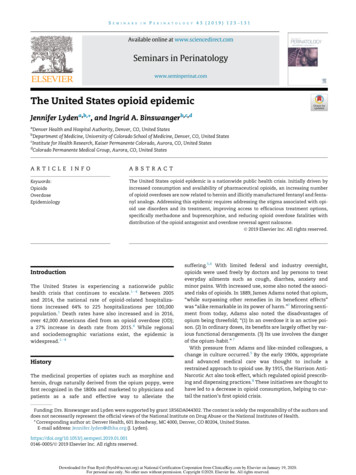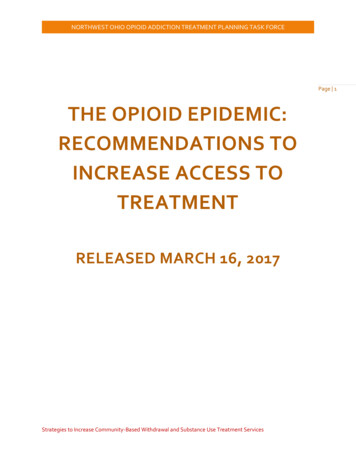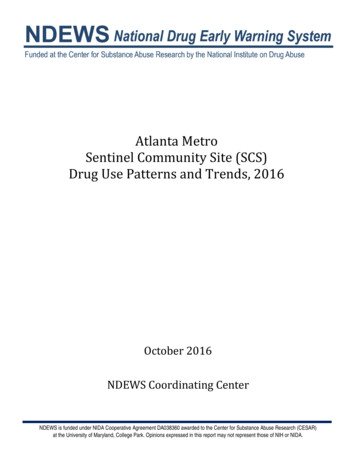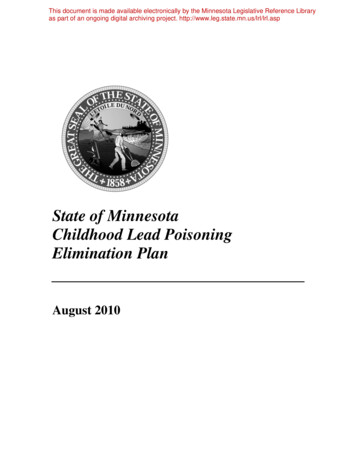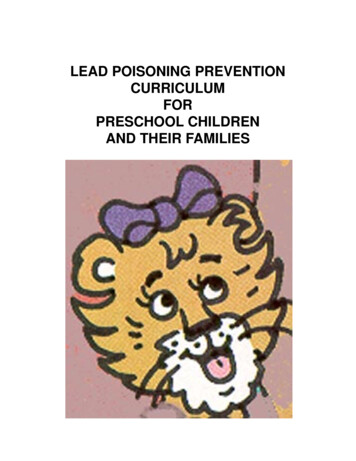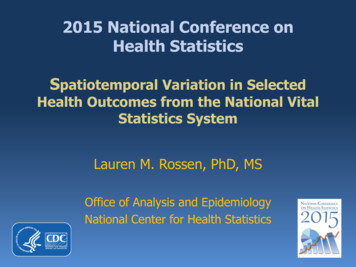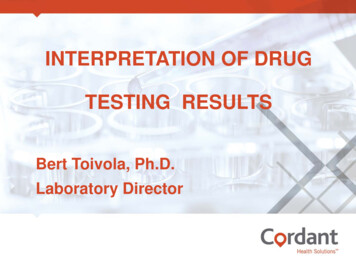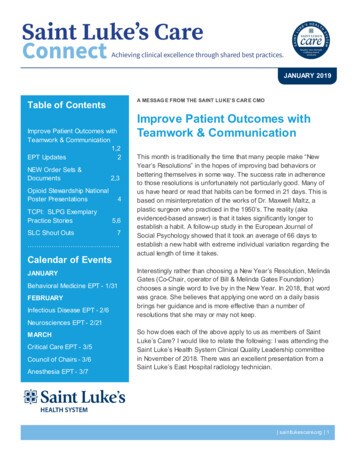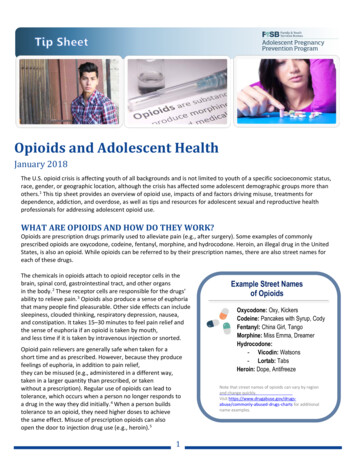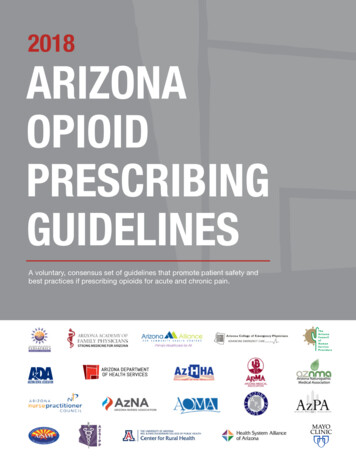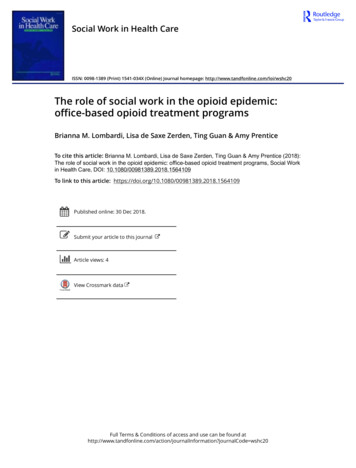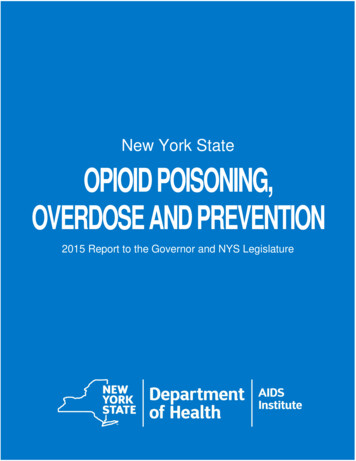
Transcription
New York StateOPIOID POISONING,OVERDOSE AND PREVENTION2015 Report to the Governor and NYS Legislature
AcknowledgementsThis report was prepared with the invaluable assistance from the following agencies: New York State Department of Health: AIDS Institute, Bureau of Emergency MedicalServices and Trauma Systems; Bureau of Occupational Health and Injury Prevention;Bureau of Narcotics Enforcement New York State Division of Criminal Justice Services New York State Office of Alcoholism and Substance Abuse Services Harm Reduction Coalitioni
Table of ContentsAcknowledgements . iIntroduction . iiiI. Opioid-Related Overdose in New York State, 2010-2015 .1Trends in Public Health Surveillance Data in NYS .1Drug-Related Overdose Deaths per Year and Trends Since 2009 .1Heroin.1Prescription Opioids .2Opioid-Related Emergency Department Outpatient Visits: Trends Since 2010 and Most RecentYear Available .3Hospitalizations with Opioid-Related Inpatient Admissions.5II. Responses .6Expansion of the NYSDOH Opioid Overdose Prevention Program.6Law Enforcement.8Pre-Hospital Services .8Emergency Medical Services (EMS) Calls: Advanced Life Support and Basic Life Support .8Intranasal Naloxone for Basic Life Support EMS Agencies .9Firefighters . 10Substance Use Disorder Treatment Trends for Opioid Dependence . 10Prescription Drug Reform. 12The Prescription Monitoring Program Registry . 12Results . 12Changes to the Controlled Substances Schedules . 13Outreach and Education . 15Safe Disposal of Unused, Unwanted or Expired Controlled Substances . 15III. Key Legislative Changes Addressing Legal Barriers to Scaling Up Opioid Overdose Preventionwith Naloxone in New York State . 16911 “Good Samaritan” Law . 16Non-Patient Specific Prescribing (“Standing Orders”). 16The Role of Syringe Exchange Programs in Preventing Overdose Deaths and Related Harm . 16Expanded Syringe Access and Safe Disposal Programs (ESAP): A Pharmacy Model . 17Combat Heroin and Prescription Drug Abuse Awareness Campaign . 17Newest Initiatives . 18Role of Pharmacies in Overdose Prevention. 18Opioid Overdose Prevention Trainings for Incarcerated Individuals Soon to Be Released fromPrison . 19Piloting Long-Acting Injectable Opioid Antagonist Treatment with Persons Under Criminal JusticeSupervision . 19Opioid Overdose Prevention Training in Schools. 19IV. Conclusions, Challenges, and Interagency Action Plans . 20Appendix A - Legal Actions Related to Opioid Overdose Prevention: Timeline. 24Appendix B - Opioid Overdose Related Mortality Data 2008-2013. 27Appendix C - Emergency Department Admissions . 34Appendix D - Opioid-Related Inpatient Hospitalizations . 38Appendix E - Naloxone Distribution to Registered Programs, 2007-2015 . 43Appendix G - Emergency Basic Medical Services . 46Appendix I - Online Resources . 50ii
Opioid Related Overdose Annual Report 2015IntroductionPublic Health Law section 3309 requires submission of a report on opioid related overdose.Thisreport provides an overview of opioid-related mortality and morbidity and other consequences ofheroin and prescription opioid misuse across the state over the last five years. It alsosummarizes new and expanded initiatives and collaborative cross-disciplinary efforts to identify,assess, and address those problems.The report reflects the work of many state and local government agencies,1 which havecollected, shared and examined data to identify where and to whom opioid overdoses areoccurring, and to help inform timely, effective public health and public safety policy andpractices to reduce the related deaths, disease, and social harms affecting New York’scommunities.Death from drug poisoning is a national issue. According to the Centers for Disease Control andPrevention (CDC), drug poisoning is the leading cause of injury-related mortality in the UnitedStates and was associated with 47,055 lives lost in 2014. About 61 percent of drug poisoningdeaths were attributed to opioids, such as heroin and prescription opioid analgesics in 2014.Heroin-related overdose deaths have tripled across the country from 2011 to 20142.A bedrock of New York State’s (NYS) response has been training first responders and otherlikely witnesses to recognize and respond to overdoses, and providing access to naloxone toreverse opioid overdoses, a practice implemented in 2006 by community harm reductionprograms under Public Health Law Section 3309. Demand for overdose prevention trainings hasgrown substantially over the past two years, and the NYS Department of Health (NYSDOH) hasresponded by training responders to go out and train others. As of this writing, more than 225agencies across NYS have registered with NYSDOH as overdose prevention programs, andhave trained more than 75,000 overdose responders who have documented more than 1,800overdose reversals. Building on the community overdose prevention model, NYSDOH hasformed strong collaborations with community partners and with state and local governmentagencies concerned with health, behavioral health, public safety and education to help turn thetide of opioid-related deaths.The goal is to ensure that those who either witness or are first on the scene of an overdosehave appropriate training to keep victims alive until they can receive medical attention. Thisreport reviews newer initiatives as well as developments in longstanding community overdoseprevention programs.These initiatives would not be possible without the legal and regulatory actions that allow forenhanced fatal overdose prevention among a wider population socially and geographicallywhere heroin and prescription opioid fatalities have increased. Appendix A is a timeline of thestatutory and regulatory changes.The rise of heroin and pharmaceutical opioid use has increased the need and demand fortreatment across the state. Treatment with opioid agonist medications has long been shown toprevent overdose fatalities and the spread of HIV, Hepatitis viruses and help people live healthylives. NYSDOH is working collaboratively with the NYS Office of Alcoholism and SubstanceAbuse Services (OASAS) and medical educational and professional organizations to increase1See Acknowledgements.Centers for Disease Control and Prevention Morbidity and Mortality Weekly Report, January 1, 2016/64(50); 1378-82.2iii
access to evidence-based medical treatment for opioid dependence and addiction, prioritizingthe areas of the state where opioid overdose is high and treatment access is low.NYS has dedicated considerable resources in 2014-15 and 2015-16 to its agencies in responseto the rising number of overdose deaths. From 2006 to 2013, NYSDOH had less than 300,000annually in State funding to provide naloxone to registered opioid overdose preventionprograms. In 2014-15, NYSDOH, OASAS and NYS Division of Criminal Justice Services(DCJS) spent more than 3.5 million on naloxone, an amount which will increase in 2015-16.NYS spends 1.2 billion annually to support the OASAS prevention, treatment, and recoverysystem, another bedrock in addressing the opioid epidemic. This includes 111 million annuallyin federal Substance Abuse Prevention and Treatment (SAPT) Block Grant funding.OASAS also received 2 million for the Combat Heroin Campaign. In addition, in September2014, OASAS was awarded more than 8 million in federal funds to help prevent prescriptiondrug misuse and abuse, heroin use, and heroin/prescription opioid overdose among peopleages 12-25. OASAS recently awarded 10 local coalitions an average of 627,000 each fromthose funds for prevention efforts through September 2019.This report concludes with a summary of anticipated challenges, as well as plans andopportunities for enhanced early response to, and prevention of, further opioid-related morbidityand mortality.iv
I. Opioid-Related Overdose in New York State, 2010-2015Trends in Public Health Surveillance Data in NYS 3During the last five years for which data are available on opioid use, misuse, morbidity, andmortality, both heroin and opioid analgesic-related deaths have increased: 2,175 drug-related deaths were reported in 2013, 40 percent more than in 2009. Heroin was involved in 637 (29 percent) of drug-related deaths in 2013 vs. 242 (16percent) in 2009. Opioid analgesic-related deaths increased 30 percent from 2009 to 2013 (from 735 to952). Naloxone was administered during 11,992 emergency medical services (EMS) calls in20144, a 57 percent increase from the previous year (7,649 in 2013). Opioid-related emergency department visits increased 73 percent from 2010 to 2014. 75,110 opioid-related inpatient hospital admissions were reported in 2014; an increase of3 percent from 2010. 118,875 (42 percent) of the 281,800 admissions to NYS certified substance abusetreatment programs in 2014 included “any opioid” as the primary, secondary or tertiarydrug problem, up 19 percent from 2010 (100,004).Drug-Related Overdose Deaths per Year and Trends Since 20095In 2009, there were 1,538 reported deaths from unintentional drug poisonings in NYS. Toxicologytests identified heroin in 242 (16 percent) of these deaths, and opioid analgesics in 735 (48percent). In 2013, the latest full year for which data are available, the number of reported drugoverdose deaths increased to 2,175, a 41 percent increase from 2009. The number of heroinrelated deaths increased in 2013 to 637, and opioid analgesics related deaths rose to 952,increases of 163 percent and 30 percent from 2009, respectively.HeroinIn 2013, an average of two New Yorkers a day died of heroin-related overdoses. More than fourtimes as many men (n 516) died of one of these overdoses compared to women (n 121). Whitesdied of heroin-related overdoses at a rate of nearly twice that of Blacks (3.95 compared to 2.12),and almost 1.35 times that of Hispanics (2.93).63456Data are not uniformly reported for the same time frames and may not fully capture activities or events forthe periods reported.Pre-hospital services data reflect only EMS calls that were reported electronically to the Bureau ofEmergency Medical Services and Trauma Systems. Although the transition to electronic reporting isnearly complete, up to 10 percent of EMS activities are recorded on paper, and not yet reflected in thereported data.These data represent deaths in which the presence of heroin or opioid analgesics was indicated intoxicology, and they are defined as heroin and opioid-related accidental deaths. Note that there may beoverlap between heroin and opioid analgesics reported. Vital Records lists the underlying cause of deathas death from drug overdose (X40-44, X60-64, X85, or Y10-14).The heroin overdose rates were calculated based on White, Black and Hispanic population data for NewYork per 100,000 provided by the U.S. Census for 2010. Rates are used here because of the differences1
The upward trend in heroin-related overdose fatalities among younger New Yorkers is particularlyalarming. Half the people who died were under age 35; the numbers rose from 85 deaths in 2009to 313 in 2013, a 268 percent increase. Of those 313 deaths, 210 were people aged 25-34 and103 were aged 15-24. The number of deaths increased among people in all age categories fromthe previous year. (See Appendix B.)The highest rates of heroin-related overdose fatalities from 2009-2013 were seen in Dutchess,Suffolk and Bronx counties. In 2015, the CDC compiled a list of all counties in the United Stateswith more than 20 reported heroin-related deaths over that time period. Below are the numbersand rates of NYS counties from the CDC’s list:Figure 1: Total Drug Deaths by NYS County Involving Heroin Between 2009 and 2013(Counties with 20 or more total deaths)* Rates are per 100,000 population.Source: Centers for Disease Control and Prevention, 2015.Prescription OpioidsThe 952 drug-related deaths in 2013 involving prescription opioids (also called “opioidanalgesics”) represent more than 18 fatalities weekly. The number of New Yorkers aged 45-54,historically the most affected of all age categories, reached a record high of 279 analgesicassociated deaths that year. Nearly twice as many men (612) as women (340) succumbed tothese overdoses. Whites died of opioid analgesic-related overdoses at twice the rate of Blacksand Hispanics (6.5 compared to 2.98 and 2.84, respectively).7 Eight deaths were counted amongAsian/Pacific Island New Yorkers in 2013 and none among American Indians/Alaska Natives;however, these racial and ethnic classifications may not reflect the true impact on thesepopulations because of imprecise and incomplete reporting.878in the racial make-up of New York residents. The 2010 census estimated New York’s population at19,378,112; 11,304,247 as White; 2,783,857 as Black; and 3,416,922 as Hispanic.Opioid analgesic death rates were calculated in the same manner as heroin deaths (see FN 6 above).See Appendix B.2
Opioid-Related Emergency Department Outpatient Visits: Trends Since 2010 andMost Recent Year AvailableHospital emergency departments (EDs) play an important role in the treatment of drug poisoning,and they also see many individuals who are at risk for opioid overdose.Statewide, there were 37,347 opioid-related outpatient ED visits9 in 2014, a 73.1 percent increasefrom 2010.10 Although these data do not necessarily reflect overdoses, they show the increasingprevalence of opioids in ED visits. Table 1 shows the growth (in frequency and rates) in opioidrelated hospital ED visits for New York City (NYC) and for the regions outside NYC for the mostrecent five years. The steep rise in ED visits outside NYC is clearly seen in Table 1 and Figure 2.Appendix C shows opioid-related ED visits for each county.Table 1: Outpatient Emergency Department Use Without Hospitalization for a Diagnosis ofHeroin, Methadone and/or Opioid-Related Narcotics Use by NYC vs. Rest of New YorkState, te2014N2010-2014% ChangeRateNew York City8,409 102.9 10,782 131.9 12,534 153.3 12,916 158.0 14,691 179.774.7%Rest of State12,554 112.1 14,083 125.7 17,645 157.5 19,271 172.0 21,576 192.671.9%UnknownNYS Total843N/A 1,005N/A1,302N/A 1,723N/A 1,480N/A21,806 112.5 25,870 133.5 31,481 162.5 33,910 175.0 37,747 194.8N/A73.1%* The rates are calculated based on the number of ED visits per 100,000 population. The population is based on U.S.Census Bureau data 2010.Source: Statewide Planning and Research Cooperative System (SPARCS)11, June 2015.Prepared by the NYSDOH, AIDS Institute, July 2015.9The 37,347 total of opioid-related outpatient emergency department visits for 2014 represents only thosewho were admitted to the ED, and not subsequently admitted as an inpatient from the ED to the hospital.10 . The 2014 data for all ED visits was calculated on July 7, 2015; and opioid-related visits was calculatedon June 24, 2015 based on these ICD-9 data codes: 304, 304.7,305.5,E850.0, E850.2,935.1,935.2,965,965.01,965.02,965.09.11 SPARCS is a comprehensive all-payer data reporting system established in 1979 as a result ofcooperation between the health care industry and government. SPARCS collects patient-level detail onpatient characteristics, diagnoses and treatments, services, and charges for each hospital inpatient stayand outpatient (ambulatory surgery, emergency department, and outpatient services) visit; and eachambulatory surgery and outpatient services visit to a hospital extension clinic and diagnostic andtreatment center licensed to provide ambulatory surgery services. The enabling legislation for SPARCSis located under Section 28.16 of the Public Health Law (PHL). SPARCS regulations are under Section400.18 of Title 10 (Health) of the Official Compilation of Codes, Rules, and Regulations of the State ofNew York (NYCRR).” https://www.health.ny.gov/statistics/sparcs/3
Figure 2: Number of Opioid-Related Outpatient Emergency Department Visits by NYC vs.Rest of New York State, 2010-2014Source: Statewide Planning and Research Cooperative System (SPARCS) June 2015.Prepared by NYSDOH, AIDS Institute, July 2015.Within NYC, Kings County (Brooklyn) has had the highest number of ED visits for opioid-relatedproblems in 2014 and historically over the last five years, as Figures 3 and 4 below illustrate.Figure 3: Frequency of Opioid-Related Emergency Department Visits within New YorkCity’s Five Boroughs, 20145% (n 741)12% (n 1,836)26% (n 3,776)BronxKingsNew YorkQueens22% (n 3,164)35% (n 5,174)RichmondSource: SPARCS, Prepared by NYSDOH, AIDS Institute, June 2015.Figure 4: Frequency of Opioid-Related Outpatient Emergency Department Visits, by NYCBorough, 2010-2014Source: SPARCS, June 2015. Prepared by NYSDOH, AIDS Institute.4
Hospitalizations with Opioid-Related Inpatient AdmissionsUsing the same SPARCS data codes for ED visits, NYSDOH examined the number of admissionsto hospitals statewide with opioid-related diagnoses over the last five years. In 2014, there were75,110 opioid-related inpatient hospital admissions. Of those, 64 percent (48,170) came via theemergency department. Adding those admissions to the outpatient-only ED visits (37,747), thetotal opioid-related ED visits to NYS emergency rooms in 2014 was 85,917.The 75,110 opioid-related inpatient hospital admissions are a 3.4 percent increase from 2010, andnearly unchanged from the year before. Nearly 60 percent of these admissions were male(47,149).Nine counties had rates of opioid-related hospital admissions higher than the state’s average of387.6 per 100,000 population. (See Appendix D for the numbers and rates for all counties.) BronxCounty had both the highest number of opioid-related admissions (11,900) and the highest rate,585.8. Among larger counties (population greater than 100,000), St. Lawrence had the highestrate (and the second-highest rate of all counties). Among smaller counties, Greene County hadthe highest rate (and the fourth highest rate of all counties). Conversely, for the first time since2010, the numbers of opioid-related hospital admissions went down in 28 counties.12Figure 5: 2014 Rates* of Opioid-Related Inpatient Hospital Admissions by County* Rates are per 100,000 population.Source: SPARCS. Prepared by NYSDOH AIDS Institute, June 2015.12SPARCS June 2015 report on frequency and rates of opioid-related hospital admissions by county.Attached in Appendix D, Tables D1-A, B.5
II. ResponsesNaloxone is made available for registered programs throughout NYS at no cost. NYSDOHprovides naloxone to all requesting programs outside NYC. Within NYC, NYSDOH providesnaloxone for intramuscular administration to all requesting programs, as well as intranasalnaloxone to drug treatment providers. The New York City Department of Health and MentalHygiene (NYCDOHMH) provides intranasal naloxone to registered programs within NYC that arenot drug treatment programs.Expansion of the NYSDOH Opioid Overdose Prevention ProgramNYS is a leader in the implementation of public health programming to prevent death from opioidoverdoses. Its multi-pronged approach focuses on building overdose response capacity withincommunities throughout the State. Complementing the longstanding efforts by EmergencyMedical Services agencies throughout NYS, this community capacity comprises trainedresponders, including opioid-dependent individuals, theirfamilies and friends, staff of agencies who work with peopleMore than 83,000 people havewho use drugs, law enforcement personnel, firefighters, drugbeen trained as overdoseprevention responders throughtreatment providers, prison guards, prisoners about to beregistered programs in NY.released and their family members, and others.The core of this program is for community “laypersons” to betrained by organizations registered with NYSDOH to recognize and respond to opioid overdoses.These individuals are known as trained overdose responders.13Under regulation, these entities may maintain regulated opioid overdose prevention programs:13 Health care facilities, such as hospitals and diagnostic and treatment clinics that areregulated by NYSDOH under Public Health Law Individual medical practitioners—including physicians, nurse practitioners and physicianassistants—as long as they are legally authorized in NYS to prescribe medication Drug treatment programs that are licensed under New York’s Mental Hygiene Law Community-based organizations incorporated under the Not-for-Profit Corporation Law Local and state government agencies Public safety agencies Institutions of higher education, approved by the Regents of the University of the State ofNew York, which provide a course of study leading to a post-secondary degree or diplomaThe following definition appears in the regulations: “Trained overdose responder means any individualnot otherwise permitted by law to administer an opioid antagonist, who is either:(i) an opioid antagonist recipient as defined in PHL Section 3309 who has successfully completed anopioid overdose prevention training curriculum offered by an authorized opioid overdose preventionprogram and has been authorized by a registered provider to possess the opioid antagonist;(ii) a public safety officer who has completed a curriculum approved by the Division of Criminal JusticeServices for purposes of intervening in opioid overdoses prior to the arrival of emergency medicalservices; or(iii) a firefighter who has completed a comparable curriculum approved by the department.”6
Business, trade, technical and occupational schools approved by the Regents of theUniversity of the State of New York or by a nationally-recognized accrediting agency orassociation accepted by the Regents Pharmacies registered under the Education LawNYSDOH’s community overdose prevention and naloxone distribution program began in 2006. Asof December 31, 2015, 270 programs have registered and are active. The registered programsinclude the 12 Addiction Treatment Centers operated by OASAS.Table 2: Overdose Responders Trained in 2015Law Enforcement14FirefightersAll OthersAll Responders4,0712405,89610,2072 Quarter 20154,4698349,53114,8343rd Quarter 2015670787,9038,6514 Quarter 20151,03532311,25812,616Total for 201510,2451,47536,75348,473Time Frame1st Quarter 2015ndthSource: NYSDOH, AIDS Institute, March 2016.The number of registered community programs is growing dramatically. For example, just 86programs were approved between 2006 (when the program started) and 2013. In contrast, 102new programs were approved during 2014 alone, with 70 more were added in 2015.Table 3: Summary of Naloxone Administration Reports through December 2015*Program Prior toTotal SinceProgram ty Program2006709177310504Law 11411427091774481,6082,942Total* Reports of naloxone administrations are current as of December 2015 for the Community Program andthe for public safety (law enforcement and firefighters) programs. They do not include EMS naloxoneadministrations.Source: NYSDOH, AIDS Institute, December 2015.As of the end of December 2015, 1,700 naloxone administrations had been reported bycommunity programs, resulting in 1,636 overdose reversals (96 percent). Due to data reportingchallenges, these 1,636 reports are thought to be a fraction of the actual number of overdoseadministrations by community programs. Each reversal may be considered a life saved. Nearly310 were reported in 2014, and 504 in 2015, respectively.15Community programs in 45 counties reported at least one administration of naloxone, led by Erie(296), then Manhattan (279), and the Bronx (248). Most naloxone administrations took place in a1415The count of trained law enforcement officers includes those officers who have received training underNYSDOH training. It does not include NYPD and those trained under the Attorney General’s Office. Theyhave separate reporting systems.The figures do not include administrations of naloxone made by public safety personnel nor by EMS (seeTable 2). NYSDOH AIDS Institute, 8/4/15.37
private residence (888), followed by on the street (303). Most of those receiving naloxone weremale (69 percent), White (56 percent) and under age 45 (71 percent), with those between theages of 25-34 (32 percent) representing the greatest number of overdosed individuals. In 76percent of the reports, the person receiving naloxone was reported to have injected heroin.16Law EnforcementLaw enforcement agencies from 56counties have submitted reports of“Patient was found unconscious in back seat ofnaloxone administrations to NYSDOH asvehicle of an apparent opiate overdose. Officerof December 31, 2015. The greatestadministered 2mg of Narcan to the aided in which shebegan to start breathing and regain consciousness.”number came from Suffolk County (234),- Suffolk County Police Departmentfollowed by Erie County (231). As 2015ended, 770 trained law enforcementresponders reported that 958 individuals(87.3 percent) to whom they had administered naloxone responded to it. Fifty-two of them (4.7)did not live. Similar to the community reports, heroin was reported to be involved in 75.8 percentof the instances when naloxone was administered, and police also reported that those betweenthe ages of 25-34 were the largest group to whom they administered naloxone (42.4 percent).17Law enforcement officers who patrol community streets can help prevent opioid overdosefatal
as death from drug overdose (X40-44, X60-64, X85, or Y10-14). 6 The heroin overdose rates were calculated based on White, Black and Hispanic population data for New York per 100,000 provided by the U.S. Census for 2010. Rates are used here because of the differences
